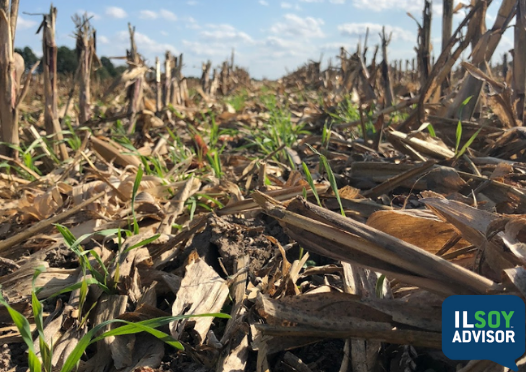ILSOYADVISOR POST
Plant and Soil Health: Are your soybeans thirsty and will yields suffer?
We can easily see corn showing drought symptoms, but signs of soybeans under drought stress may not be as evident. When soybeans suffer from heat and water stress, their response may vary due to their cellular structures, metabolic processes, and physiological development, which all can directly and indirectly cause soybeans to exhibit symptoms based on their response. Early season soybean stress may cause leaves to be smaller or limit vegetative growth, thus more energy and efforts may be given to root development.
A more obvious sign may be leaf flipping, which is like corn rolling. Soybeans may flip leaves to reflect more sunlight by exposing the silver-green leaf underside. This can conserve water by reducing plant temperature stress and photosynthetic rates. Ultimately, the earlier and longer the leaf flipping occurs, the worse the severity. Lastly, extremely drought stressed soybeans will exhibit leaf clamping. In other words, the leaves all fold in like a taco and this can occur anytime throughout the growing season when stress is severe enough.
When compared to corn, soybeans overall can better adapt in times of moisture stress. Actually, indeterminate soybeans can handle moisture stress over a longer period of time and range of growth stages. This is because indeterminate soybeans continue to grow during its reproductive stages and can compensate for drought if growth has been reduced at previous stages. But, ultimately, nitrogen fixation can be severely limited or completely halted by even moderate drought stress. Remember back to 2012 when corn in Illinois died in the field while soybean growth stalled to conserve water and when rains returned in mid-August plants bounced back and filled out remaining pods that survived and yields were not too far below normal.
Drought stress will impact yield the most during germination and reproductive seed development. The time of latter pod formation is especially critical because flowering has stopped and there is no longer any compensation for lost pods. The main source of yield reduction at this time is a reduction in total pods per plant, because younger pods will be more susceptible to abortion under stress, compared to older pods/seeds that set earlier. If rain occurs after R5 (pod fill), depending on soybean genetics, seed size could still compensate for yield reductions.
Dry weather is the greatest threat to soybean productivity and, ultimately, profitability, and it is something you can’t control unless you irrigate. There are management practices such as less tillage, increased soil residue or reduced compaction that can help to increase the soil moisture content, nitrogen fixation, and soybean yield during growing seasons with drought.
The soybean’s genetic basis of drought tolerance is not well understood and the key may be understanding how plant growth and development or adaptive traits such as rooting depth, water use efficiency, nitrogen fixation, and differences in leaf wilting can provide drought tolerance. Research is ongoing; most soybean types have been found to lose more water via their leaves under dry conditions than otherwise.
More water-efficient soybean lines have been identified and can be used in breeding in order to limit water use early in the growing season in dry conditions. Previous research showed that nitrogen fixation is the most important drought tolerant trait and was predicted to help increase yield in dry years in the U.S. Breeding now has brought us new soybean varieties with drought-tolerant nitrogen fixation and higher yields under drought conditions. But, we continue to seek out other genetic resources for specific traits to further increase yields during drought.
Stephanie Porter is a Sales Agronomist with Burrus® Hybrids with responsibilities that include educating growers and Burrus staff on all types of pests, weeds, diseases and other agronomic issues that affect corn, soybean and alfalfa production. Her territory encompasses Southern Wisconsin as well as Northern, Eastern and Southern Illinois.




Comments
Add new comment